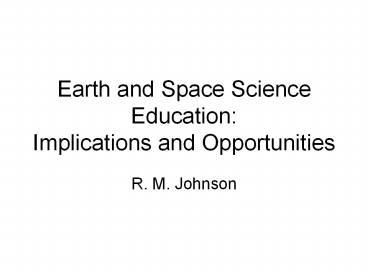Earth and Space Science Education: Implications and Opportunities PowerPoint PPT Presentation
1 / 19
Title: Earth and Space Science Education: Implications and Opportunities
1
Earth and Space Science Education Implications
and Opportunities
- R. M. Johnson
2
(No Transcript)
3
(No Transcript)
4
Earth and Space Science What are the
Implications and Opportunities for Education?
- Programmatic decisions
- Definition of new scientific and education
structures and relationships within NASA is
underway - Science Mission Directorate (SMD)
- Relationship to Education Office
- How will education be represented in SMD?
- How will education program be structured?
- Well need to wait awhile
- For now, lets focus on opportunities for
education through Earth and space science
5
NSES Content Standards, Grades 9-12
6
Fundamental Earth System Science Questions
How is the Earth changing and what are the
consequences of life on Earth?
- How is the global Earth system changing?
- What are the primary forcings of the Earth
system? - How does the Earth system respond to natural and
human-induced changes? - What are the consequences of changes in the Earth
system for human civilization? - How well can we predict future changes in the
Earth system?
7
Space Science EnterpriseScience Themes
- Structure and Evolution of the Universe
- What is dark matter that binds together the
universe? - What powered the big bang?
- What is the dark energy that drives apart the
universe? - Are there hidden space-time dimensions?
- What is the nature of black holes and gravity
beyond Einstein?
- Astronomical Search for Origins
- Where Did We Come From?
- Are We Alone?
- Sun Earth Connection
- What causes solar variability?
- How does solar variability affect the Earth and
other planets? - How does solar variability affect life and
society? - How does the Sun interact with the interstellar
medium?
- Solar System Exploration
- How do planets form?
- Why are planets different fromone another?
- Where did the makings of life come from?
- Did life arise elsewhere in the solar system?
- What is the future habitabilityof earth and
other planets?
- Mars Exploration
- Did life ever arise on Mars?
- How did Mars atmosphere, surface, and interior
evolve? - What knowledge and technology is needed for
future human exploration?
8
Space Science EnterpriseScience Themes
- Structure and Evolution of the Universe
- What is dark matter that binds together the
universe? - What powered the big bang?
- What is the dark energy that drives apart the
universe? - Are there hidden space-time dimensions?
- What is the nature of black holes and gravity
beyond Einstein?
- Astronomical Search for Origins
- Where Did We Come From?
- Are We Alone?
- Sun Earth Connection
- What causes solar variability?
- How does solar variability affect the Earth and
other planets? - How does solar variability affect life and
society? - How does the Sun interact with the interstellar
medium?
- Solar System Exploration
- How do planets form?
- Why are planets different fromone another?
- Where did the makings of life come from?
- Did life arise elsewhere in the solar system?
- What is the future habitabilityof earth and
other planets?
- Mars Exploration
- Did life ever arise on Mars?
- How did Mars atmosphere, surface, and interior
evolve? - What knowledge and technology is needed for
future human exploration?
9
How does the Sun impact Earth System Science?
- The Sun is one of the key driving forces of the
Earth system - Solar variability impacts Earth systems in
numerous ways - Climate forcing terms
- Changes in radiation
- Drives large scale dynamics of the atmosphere
- Short-term variability impacts interaction of
magnetosphere with the solar wind/magnetic field,
and the coupled magnetosphere-ionosphere-thermosph
ere system.
10
(No Transcript)
11
Sun-Earth Relationships and Space Weather
- Solar Radiation
- Solar influences on Climate
- Space Weather
12
(No Transcript)
13
(No Transcript)
14
- Energetic particle precipitation in the
atmosphere - Changes in solar radiation at different levels of
the atmosphere - Changes in atmospheric chemistry
- Possible impacts on weather?
15
Relevance of Models to the NSES
- Models and concepts associated with them are
central to the Unifying Concepts and Processes
content standard - Systems, order, and organization
- Evidence, models, and explanation
- Constancy, change, and measurement
- Evolution and equilibrium
- Models also provide a tool for exploring the
concepts included in the other content standards - Science as Inquiry
- Physical Science
- Life Science
- Earth and Space Science
- Science and Technology
- Science in Personal and Social Perspectives
- History and Nature of Science
- Earth and Space Science provides an even broader
context for using models in science education
16
Earth System Modeling
17
The Benefit of an Earth and Space Science
perspective an example
- Volcanic forcing produces cooling, solar cycle
forcing produces warming - Need natural anthropogenic forcing to reproduce
observed warming
18
Snapshot of density in noon-midnight meridian
from MHD code simulation of July 15, 2000
CME-magnetic cloud interaction with Earth's
magnetosphere. Simulation driven by upstream
solar wind parameters measured by the ACE
spacecraft at L1.
19
Summary
- Fundamental Earth system science questions are
related to space science questions - Lessons we learn from study of the Earth informs
our research on other planets, and visa versa - Earth and space science is considered as a unit
in the NSES, and is taught as a continuum in many
settings - Expanding our educational scope to include Earth
and space science topics together broadens our
ability to bring NASA research to learners,
through both observations and models

